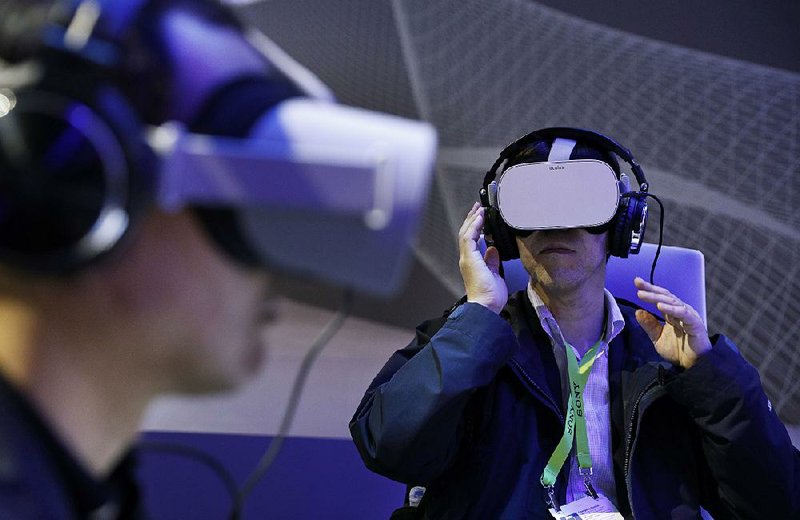NEW YORK -- Just a few years ago, virtual reality was poised to take over the world. After decades of near misses, the revolution finally seemed imminent, with slick consumer headsets about to hit the market and industries from gaming and entertainment to social media ready to hop on the bandwagon.
But the buzz has faded to a whisper. At the Consumer Electronics Show 2019 tech conference in Las Vegas this week, Facebook's Oculus unit isn't holding any glitzy press events, just private demonstrations for its upcoming Oculus Quest, a $399 untethered headset due out in the spring. Other virtual reality companies are similarly subdued. HTC Global Services announced two new headsets -- one with only scant details -- while Sony has some kiosks for its $300 PlayStation virtual-reality set in the main hall.
It's a world away from the scene a few years ago, when virtual-reality products from Samsung, Oculus, HTC and Sony seemed omnipresent and unstoppable at the conference. These days, virtual reality is mostly a niche product for gaming and business training, held back by expensive, clunky headsets, a paucity of interesting software and other technological shortcomings.
"VR hasn't escaped the early adopter, gamer-oriented segment," said Forrester analyst J.P. Gownder -- himself an early adopter who chafed in 2016 at delays in shipping Facebook's then-groundbreaking Oculus Rift system. Gownder said many existing virtual-reality setups are still too hard to use; even simpler mobile systems like Samsung's Gear, he said, don't offer "a clear reason for the average non-gamer to get involved."
Virtual-reality proponents are still dreaming big, although the challenges remain formidable. Shipments of headsets rose 8 percent in the third quarter compared with the previous year, to 1.9 million units, according to data research firm International Data Corp. -- an uptick that followed four consecutive quarters of decline. Nearly a quarter of a million units of Facebook's Oculus Go and Xiaomi's Mi virtual reality -- the same stand-alone headset, sold under different names in different markets -- shipped worldwide in the quarter, International Data Corp. said.
Those still aren't huge numbers for a technology that seemed to hold such promise in 2012 when early demonstrations of the Oculus Rift wowed audiences -- so much that Facebook acquired Oculus for $2 billion two years later. Despite large sums pumped into the field by Facebook, Sony, Samsung, Microsoft and Google, virtual reality hasn't yet made much of a dent in the real world.
Some of the biggest consumer complaints involve expense, laggy or glitchy graphics and the fact that many systems still tether the headsets to gaming consoles or PCs. "Technology is still what's holding VR back," said eMarketer analyst Victoria Petrock. Upcoming stand-alone headsets like the Oculus Quest could solve some of those problems.
But virtual reality still suffers from a lack of popular software. Many major game publishers have largely avoided the field so far, and venture funding for virtual-reality software development has nosedived this year.
SuperData, a digital games and virtual-reality market research company owned by Nielsen Holdings, estimates that consumer virtual-reality software investments dropped by 59 percent in 2018, to $173 million from $420 million the year before.
Software makers are retrenching. Imax said in late December that it was shutting down its virtual-reality unit. Jaunt, a startup focused on cinematic virtual reality and once backed by Disney, restructured this year. Its new focus? Virtual reality's cousin technology, "augmented reality," which paints consumer-simulated objects into the real world, a la the cartoony monsters of Pokemon Go.
A few games have been modest hits. Beat Saber a virtual-reality game in which players move a lightsaber to music, sold more than 100,000 copies in its first month and became the seventh highest-rated game on Steam, according to Forbes. But such titles are few and far between.
There's one other problem: Virtual reality isn't very social, Petrock said. There's no easy way to share the experience with others on social media or within the games themselves, making a virtual-reality experience less likely to gain a wide audience the way, say, Fortnite has. "You have your headset strapped on and you're in a virtual world but it is solitary," she said.
Virtual reality "is still is the next big thing, but anything good takes time and effort," said Gartner analyst Tuong Nguyen. "The industry as a whole did overhype it."
He compares the current virtual-reality industry to the TV industry when HDTV first came out. People bought new high-definition sets but were disappointed when there wasn't anything to watch in the new format. For virtual reality, "the kind of breadth and depth of content isn't all quite there," he said.
Information for this article was contributed by Rachel Lerman of The Associated Press.
Business on 01/10/2019

